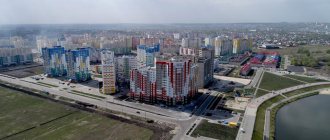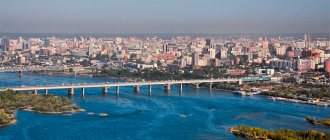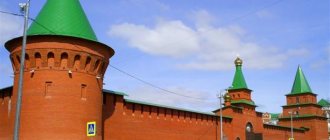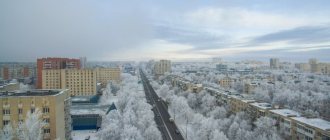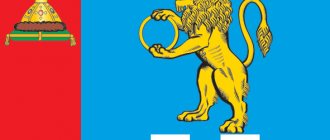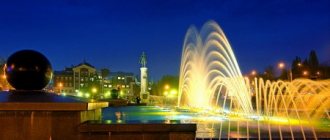It’s deep night for residents of central Russia, and residents of Khabarovsk are already rushing to work. The city is located 30 kilometers from the border with China, a different time zone, by which one can judge how far the administrative center of the Far Eastern District and Khabarovsk Territory is located from the capital of the Russian Federation - 8 thousand kilometers. If you are ready to spend more than eight hours in the air and the same number of days traveling by rail, enjoy your acquaintance with the large Far Eastern center!
History of the city of Khabarovsk
The name of the city Khabarovsk is associated with the name of the explorer Khabarov, a former peasant. Erofey Khabarov heard rumors about the wealth of Daurova land (Amur region), and he set off to look for untold riches following the expedition of Vasily Poyarkov. Desperate explorers discovered a short route to the Amur, gathered a small detachment and set off along the Urka River, down to the Amur. Nowadays the Erofey Pavlovich railway station is located here.
Their deserted cities were greeted by appanage princes who, having heard about the campaign of the conquerors, hastily left the inhabited areas. The expedition continued for several years, many died in battles with Manchu troops. Khabarov himself, although he settled Dauria with Russian people, fell into disgrace with the tsar and was placed in the Yakut prison. But the border post on the banks of the conquered Amur, near the Chinese border, received the name Khabarovka a century later.
At the end of the 19th century, the city of Khabarovsk became the center of the Primorsky region. In Soviet times, it received the status of the capital of the Far Eastern Territory, and then of Khabarovsk. The population of the city at that time barely exceeded 50 thousand people.
The real flourishing of the region occurred in the middle of the last century: industry was created, trams appeared on the city streets, institutes, a theater, and the first museums began to operate.
In new history, the city is experiencing a rebirth in connection with the Russia-EU summit. Today Khabarovsk is the largest industrial, scientific and cultural center in the Far East, closely connected by sister cities with Japan, China, Korea, and Canada.
Development of Khabarovka in the 19th century
For the first couple of years, “life went on without any entertainment or even impressions.” So much so that even letters and newspapers were read several times - mail arrived twice a month, and even then only in winter and summer, because “during the thaw we were cut off from the world for almost 2 months.”
Throughout the second half of the 19th century and until Russia entered the First World War, Khabarovsk gradually developed and was built up. For the first few years of Khabarovka's existence, all residential wooden development was carried out chaotically, and there were no official street names.
View of Srednaya Mountain from the Plyusninka River. End of the 19th century. At the top you can see the Assumption Cathedral and the triumphal arch, built for the visit of Tsarevich Nikolai Alexandrovich
An officer and journalist, P. N. Krasnov, who visited Khabarovka during this period, wrote in his diary:
“A city without a plan, without a drawing. Everyone built his own house wherever he wanted, demarcating for himself as much space as he wanted...”
In 1864, military topographer Marcelius Martynovich Lyubensky developed a plan for the development of the settlement with the prospect of turning it into a commercial and industrial city. The basis for urban planning was the natural landscape. The key elements of the city's layout were the almost parallel hills facing the Amur. Sometimes in the literature they are called the distant spurs of the Sikhote-Alin. The urban planning plan included a regular network of streets, which today forms the basis of the historical center of Khabarovsk.
General plan of Khabarovka by land surveyor of the Primorsky region Lyubensky in 1864
In 1872, Khabarovka was just beginning to be built and looked unsightly. There were few residents, about 500 people, “including the soldiers of the guard team.” Rumors that Khabarovka would become a city spread back in 1876. Artillery depots and a mining division were transferred here from Nikolaevsk.
In 1880, the capital of the Primorsky region was moved from Nikolaevsk to Khabarovka. The village acquires the status of a city , and a separate building is being built in it for the residence of the governor of the Primorsky region. By this time, the settlement had about 2 thousand inhabitants and 855 buildings. Of these, only 5 houses stood on stone foundations. All other private houses were slums typical of Tsarist Russia: chaotic “blocks of wood” without normal infrastructure. Urban inhabitants lived in them: small artisans, traders and office workers.
In 1884, the East Siberian General Government was divided into two military-administrative units: the Irkutsk and Amur General Governments. Khabarovka became the capital of the Amur General Government. The administration of the Amur region was also located here. This year the population of the young city reached 4 thousand people. Of these: 3340 Russians and 519 Chinese.
The acquisition of regional and then provincial rank caused a construction boom in Khabarovka. It was during this period that the first brick buildings appeared in the city. Many of these houses, whose history dates back to the end of the 19th century, have survived in Khabarovsk to this day and are protected as architectural monuments of federal significance.
Stone houses of Khabarovsk, built at the end of the 19th century. Some of them were built on in the 20th century. Clockwise: 1. The first wing of the Local History Museum was commissioned in 1896; 2. Management (Volochaevskaya, 146). Former apartment building of J. A. Smagi; 3. Apartment house of A. M. Baluev (Zaparina, 84); 4. Office of the Amur Governor-General - the first two floors are decorated in the style of Russian brickwork. The third and fourth floors were built during Soviet times.
Ancient buildings in the center of Khabarovsk, preserved in their original form and protected by the state as historical and architectural monuments. Clockwise: 1. Far Eastern State Scientific Library, former apartment building of the Plyusnin merchants; 2. An architectural monument of the early 20th century. Protected by the state; 3. Apartment house of the Dyakonovs until 1912; 4. Headquarters building of the Amur Military District.
Climate and ecology of Khabarovsk
Considering the proximity of the sea and several waterways in the city itself, the climate of Khabarovsk is sharply continental, somewhat similar to Siberian. In winter, the air is dry, the temperature stays between 20-25 degrees. Precipitation is rare, as in summer. But disasters happen: a flood in the summer of 2013 and unimaginable snowstorms in the winter of 2015. In winter there are rare days with temperatures of at least 40 degrees. But this is rather an exception; usually stable temperatures remain around minus 20.
Summer is moderately warm 20-25 degrees. The heat in the seaside city lasts no more than 3 weeks. The thermometer then shows 30-35 degrees. Townspeople rush to the sea, just like during the velvet season, which begins in late August and early September. Sea water warms up to 25 degrees.
Pleasant weather and relaxation are disrupted by the invasion of ticks and midges. This period in the Far East lasts from May to September.
The ecology does not cause any particular distress to the townspeople: the wind from the Amur does a grateful job of dispersing the smog. Only when there is no wind do citizens sometimes feel that the air in Khabarovsk is polluted. However, emissions from vehicles do not significantly exceed permissible MPC standards.
A constant source of air pollution is the city's thermal energy sources; three thermal power plants operate in the surrounding area. Residential areas located in close proximity to them are among the cheapest. But this is for the time being: Khabarovsk has adopted a municipal program for the environmental safety of nearby territories. It is hoped that powerful air purification filters will be installed to minimize the release of hazardous substances.
Popular message topics
- Maslenitsa
Maslenitsa is one of the oldest Slavic holidays, very loved by people; it has existed since pagan times. The main idea of the holiday is farewell to winter. After the adoption of Christianity in Rus', Maslenitsa began to be celebrated during - Discovery of Australia
Australia, a continent that is rightfully considered the smallest and most remote, became known to the world on January 1, 1901 as the Commonwealth of Australia, a de facto independent state within the British Empire. - Natural gas
The concept of “natural gas” is a generalized term for a combination of gases formed as a result of the destruction of various organic substances in the earth’s crust under high pressure.
Population and labor market in Khabarovsk
At the beginning of 2015, the city's population was just over 600 thousand people. Over the last decade it has increased by 20 thousand citizens. The city fathers believe that the positive dynamics in the demographic situation of the city was achieved due to:
- the city's attractiveness for young families;
- construction of housing, kindergartens, schools and clinics;
- increasing the birth rate;
- reduction in mortality;
- high salaries and standard of living;
- increasing the flow of migrants.
Khabarovsk has a low unemployment rate. At the beginning of 2015, official data was 0.41 percent. Only 1,300 city residents are registered as unemployed, and the number of vacant jobs is approaching 10 thousand. Industrial enterprises require machine operators, turners, and mechanics. The employer is ready to pay highly skilled workers and engineers a salary that is significantly higher than the average for the regional center.
The employment center offers a large number of vacancies. Among them:
- tower crane operators;
- masons;
- finishers;
- foremen;
- drivers of heavy vehicles;
- bulldozer drivers;
- gas-electric welders;
- teachers;
- a kindergarten teacher;
- doctors;
- nurses;
- nurses;
- accountants;
- sellers.
The average salary in Khabarovsk is considered one of the highest in the region, over 35 thousand rubles. The fixed cost of the minimum basket is about 12 thousand rubles. As you can see, the standard of living in the capital of the region is quite high.
Tips, routes and reviews from tourists
People usually come to Khabarovsk while passing through, for a visit or for work. Tourists often become residents of nearby regions. The largest flow of guests occurs in the warm season. In their reviews, tourists talk about the routes they have taken, the places they have seen, and always share their thoughts about their expectations and impressions.
- The story “Meet Khabarovsk!” from Dmitry
- The story “Khabarovsk - the Amur handsome man” from Anna Kudryavtseva
- The story “Khabarovsk??? Where is it?!!" from Julia
All tourist reviews about Khabarovsk on Tourist. RU
And also if you are going for a longer period:
What to see in Khabarovsk in 2 days
And one more thing: What to bring from Khabarovsk
Amur within the city Photo: © Anna Kudryavtseva
Industry, investments, budget of Khabarovsk
The capital of the region is a large industrial center. The entire Far East supplies fuels and lubricants (gasoline, motor fuel), and oil refineries export them abroad. In the structure of the regional gross product, the energy complex occupies a dominant place; a third of the gross output falls on its share.
There are several shipbuilding factories in the city, united into a corporation. Military and civilian vessels, including submarines, are produced here. The factories successfully survived the crisis in 2010-2011 and received large government orders. Today there are several job vacancies open here. Branches of the shipbuilding college have been opened at the Kirov plant and the Khabarovsk shipyard, where additional training programs for blue-collar jobs have been opened.
Wood processing occupies third place in the structure of industrial enterprises. The city is home to the headquarters of the largest logging holding company.
Khabarovsk enterprises also produce:
- machine equipment;
- metal constructions;
- cables and conductors;
- heating equipment;
- diesel engines;
- cash registers;
- water meters;
- reinforced concrete wall panels;
- brick;
- clothes;
- candies;
- medications;
- dressings;
- fish delicacies;
- liquor products.
There are artels for the extraction of minerals, non-metallic materials, gold and platinum.
Defense orders from aircraft manufacturing enterprises more than doubled in 2014. In the shipbuilding industry one and a half times.
Due to its geographical location, the city attracts a large amount of foreign investment. Primarily from China. The largest Russian companies are investing in the development of logging and wood processing. An investment program for the construction of housing, other capital construction projects, and commercial real estate has been in effect for more than ten years.
Investments in fixed capital of the region's industrial complex in 2014 increased one and a half times and exceeded 2.5 billion rubles.
Budget revenues in 2015 are planned in the amount of 12.6 billion rubles. The third part of the city treasury income is the personal income tax. Two-thirds of budget expenditures go to the implementation of social programs to improve the quality of life of citizens. As an anti-crisis measure, officials' salaries will be reduced by 10 percent in 2015.
Housing market and new buildings
The housing issue for city residents does not lose its urgency: little is being built, and the price per square meter is truly golden. In the Russian ranking of cities in terms of housing costs, Khabarovsk occupies an honorable third place, behind only two capitals, the average price per square meter is over 72 thousand rubles. Real estate here is more expensive than in Sochi and the Leningrad region. This is explained by the following factors:
- slowdown in construction rates;
- lack of vacant land plots;
- expensive building materials produced in the region;
- high cost of technological connections (electricity, gas, water).
The government of the regional capital has developed a number of targeted programs aimed at increasing construction volumes, reducing the cost of housing for developers, and the availability of utility networks. By 2021, officials promised to reduce prices by 20 percent and increase the volume of housing commissioning to 1.3 million square meters, three times more than in 2014. The authorities will annually allocate 250 hectares of land for these purposes.
In the meantime, the situation on the housing market is very tense. Half of the city's population needs improved housing conditions. But 80 percent of new housing is in the elite category. Less than 10 percent of Khabarovsk residents are able to purchase such expensive housing.
In the Central district of the city, the cost per square meter in a brick high-rise building is in the range of 115-125 thousand rubles. This area cannot be classified as densely populated, with just over 90 thousand people living there.
But in the Industrial district of the regional capital, the population exceeds 200 thousand people, taking into account the adjacent satellites Ilyinka, Krasnorechenskoye, Sosnovka, Ussuriysky. The area stretches along the Amur Channel, is very picturesque, including dozens of microdistricts and residential complexes:
- Southern;
- Red River;
- Builder;
- Crown;
- Flegontova;
- Coastal;
- Fifth platform.
Here you can buy housing from 75 thousand rubles per square meter in a new building. The infrastructure is well developed, transport links include trams, trolleybuses, and buses.
On the border of the Central and Industrial districts, the Golden Keys residential complex was built with 360 new open-plan apartments, with underground parking for 100 cars. The cost per square meter is from 73 to 90 thousand rubles per square.
The Zheleznodorozhny district, located in the eastern part of the city, is also densely populated; more than 150 thousand people live in the following microdistricts:
- New;
- Manor;
- Air City;
- Sunny Polyana;
- Big Dipper;
- Vyborg.
In the area there is the tallest building in the city, the New Quarter, 107 meters, 32 floors. But the hotel building being built nearby is planned to consist of high-rise buildings above 150 meters and 53 floors.
The area is built up with high-rise buildings from 10 to 26 floors. Dozens of the largest shopping centers are concentrated here, and the largest market in the Far East, Vyborg, is located. By the way, the city has a large number of small markets where you can cheaply buy Chinese goods and fish delicacies that you will not find anywhere else except Khabarovsk.
In the Zheleznodorozhny district you can find housing from 55 thousand rubles per square meter in the old housing stock. Such apartments belong to economy class. The construction of the Sozvezdie housing complex has begun - two 25-storey buildings with 300 apartments. At the construction stage, you can conclude an agreement to purchase apartments for 72-84 thousand rubles per square meter. The complex is being built using Korean technologies.
The Krasnoflotsky district of the Capital is an administrative, cultural, commercial and historical center. You can buy a two-room apartment with a view of the Amur for 2.7 million rubles (50 square meters). Nearby they offer to buy a 14-meter room in a communal apartment for 1.45 million rubles. Housing in this area is the cheapest in the city, located in old housing stock.
Only 50 thousand people live in the Kirovsky district, the right bank part of the city. There is an oil refinery, a river port, and a thermal power plant here. The ecology of this part of the city leaves much to be desired. Apartments even in Brezhnevka are expensive: from 80 thousand rubles per square meter.
Low-rise construction is underway in the outskirts of the city. Noteworthy is the well-maintained Sunny City complex, a 10-minute drive from the center. There is a large park area on its territory. The territory is guarded around the clock, entry is through a checkpoint. There are shops, a kindergarten, convenient parking, and sports grounds. Round price per square meter: 100 thousand rubles.
The Aurora cottage community is located in picturesque surroundings, in a forested area, a kilometer from the airport. Apartments from 140 to 170 square meters, with a land plot of 4 acres. The houses are under construction. At this stage, you can purchase housing from the developer for 48 thousand rubles per square meter. This is the best offer on the city housing market.
Reasonable prices and comfortable living conditions can be found in other cottage villages:
- Everest;
- Aviacity;
- Matveevka;
- Estate.
They are located in environmentally friendly places, away from city noise.
What to see with your child
Entertainment centers, playgrounds and attractions in parks are open in Khabarovsk, but visiting some places will be especially unusual for young tourists or local residents.
Be sure to visit the “Fish of the Amur” museum-aquarium on Amursky Boulevard. The exposure is small and will not let the child get tired. The museum’s aquariums are home to fish from the Amur and other local rivers—about a hundred species in total. It is surprising that most of them are not familiar even to adults. A detailed story from the guide will make the learning process easier and more exciting.
Expositions and aquariums of the Amur Fish Museum Photo: © Museum “Fishes of the Amur”
In the Priamursky Zoo named after. V. P. Sysoev presents the inhabitants of local forests. The spacious park area is occupied by enclosures with tigers, red wolves, leopards, forest Amur seals, badgers, moose, foxes and many other animals familiar to children from Russian fairy tales. There are also visiting guests, like a charismatic polar bear named Khabar and the growing king of animals - the lion Aslan. All the animals came to the park due to circumstances: they were born in captivity, were left without a mother, or due to health reasons could no longer survive in the wild.
Lynx from the Khabarovsk Zoo Photo: © Oleg Sarapulov
Museum of Living History on the street. Radishcheva is a cultural center dedicated to the history of the Middle Ages. Both girls and boys are delighted with his visit, because here you can not only touch the weapons and armor of the Vikings or Russians. The most interesting moment for them is their personal participation: they can try on antique costumes, put on chain mail, take up fencing or archery, or forge a nail with their own hands using old technology.
In good weather, check out the Gaidar Children's Park , where there is a large selection of children's playgrounds and attractions for all ages, and see the cartoon characters in Dynamo Park . If the weather takes you by surprise, go to the building located in the park. Transformers, slot machines, a laser maze, a room of illusions and much more will definitely please your child. In addition, you can have a snack in cheerful cafes and visit a mini-menagerie.
More options for having fun with your child in a special material:
Khabarovsk for children
Heroes of the Bremen Town Musicians in Dynamo Park Photo: © Oleg Zhuravel
Sights and culture
The architecture of the city on the Amur combines ancient low buildings and new buildings reaching into the sky. This can already be seen on the main street of the city of Muravyov Amursky, which bears the name of the Governor-General of Eastern Siberia. Along it you can walk to the central Lenin Square, second in size only to Red Square. In summer it is surrounded by greenery, flowers, and decorated with fountains.
The youngest square in the city is named after Victory. On the high bank of the Amur, pylons with the names of heroes were installed, and the Eternal Flame was lit.
A river bus along the Amur leaves from the central park, from which a magnificent view of the city opens. The park also has an observation deck on a cliff, from which you can admire the majestic river and go down to it along the steps of the embankment.
We recommend taking a walk along the new bridge, which is called the Amur Miracle: the length is more than 2.5 kilometers, the height is 64 meters. On the lower tier there are railway tracks, above there is a two-lane highway, and there are pedestrian paths. The Amur Bridge has its own museum, which is interesting to visit.
The city has many park areas, public gardens, and green spaces. In the center there is an arboretum, where plants of the Ussuri taiga, Tien Shan, and Himalayas are presented on 11 hectares. Exotic species of birch grow here:
- stone;
- iron;
- black;
- flat-leaved.
Orthodox shrines are represented by the Church of St. Innocent of Irkutsk and the Holy Transfiguration Cathedral, which in size is second only to St. Isaac's Cathedral and the Cathedral of Christ the Savior. Its height is 95 meters.
At the Far Eastern Art Museum you can admire the masterpieces of Russian Itinerant artists and get acquainted with modern art.
The history of the city will come to life before your eyes in the N. Grodekov Local Lore Museum and the History Museum. Children will be interested in visiting the aquarium museum, where about a hundred species of fish living in the Amur and its basin are presented.
The Drama Theatre, the Musical Comedy Theater and the Triad Pantomime Theater are popular among city residents. If you stay in the city on the Amur for several days, you can visit numerous cinemas, exhibition halls, cultural entertainment and sports centers.
Architectural delights and monuments
Curious tourists have something to see in Khabarovsk. Although the city cannot boast of a long history, there are plenty of monuments and original buildings built at different times on its streets.
The building of the former City Council
- Address: st. Muravyova-Amursky, 17. Transport stop "Glavpochtamt".
The architectural pearl of the front facade of Khabarovsk, Muravyov-Amursky Street, is the building in whose halls the City Duma met until 1917, and now houses the Center for Children's Creativity. The magnificent mansion attracts with its eclectic architecture and splendid decor. What makes its exterior original are the intricate turrets with kokoshniks, very similar in shape to pagodas. The facade is decorated with large windows in arched openings, half-columns, and elegant stucco molding. It’s worth taking souvenir photos against the backdrop of the colorful building.
Takeuchi Apartment House
- Address: st. Muravyov-Amursky, 5. Transport stop “Regional Library”.
One of the most beautiful buildings in the city is considered to be a mansion built at the end of the 19th century, which once housed an apartment building. Its first owner was the chairman of the city Japan Society, Ichiji Takeuchi, as evidenced by the family monograms embossed on the facade. The main decoration of the two-story building with original attics is a luxurious bay window topped with a slightly flattened dome. The mansion, which at various times housed a photo studio, a jewelry store, a hotel, an elite restaurant and even a casino, looks incredibly elegant.
Arena Platinum
- Address: st. Dikopoltseva, 12. Transport stop "DGU".
People began to talk about the need to build a spacious sports and entertainment complex in Khabarovsk at the end of the last century, but money for the project was found only in this century. The arena, inaugurated in 2003, is considered one of the city’s most beautiful urban-style buildings erected in modern times. The structure made of concrete and glass, capable of accommodating up to 7,100 spectators, does not look massive, blending harmoniously into the green area with picturesque alleys and fountains. Its forms are graceful, the lines of the facade are smooth. The Platinum Arena is home to the Amur hockey team. Roxette, Deep Purple, and Nazareth performed on the stage under its vaults.
Monument to the Liberators of the Far East
- Address: Komsomolskaya Square. Transport stop "Komsomolskaya Square".
The grandiose monument, which became one of the symbols of Soviet Khabarovsk, was inaugurated in 1956. It is dedicated to the memory of the soldiers of V. Blucher’s army who died during the liberation of the city during the suppression of the counter-revolutionary rebellion in 1921. The dominant composition is an obelisk crowned with a wreath and a five-pointed star . On the pedestal at the base of the stele there are bronze sculptures of a Red Guard soldier, a partisan and a commissar, shaded by the regimental banner. The height of the monument is 22 m.
Fountain on Lenin Square
- Address: Lenin Square. Transport stop "Lenin Square".
The main cultural events are held on Lenin Square: military parades, festivals, concerts. The pearl of its composition is considered to be a magnificent fountain, surrounded by well-groomed flower beds and elegant lanterns. In the center of the concentric pool, from the walls of which geysers gush, rises a luxurious granite bowl in which a central nozzle is installed. Around it there are eight graceful flowerpots, also emitting streams of water. In the evenings, when the multi-colored lights turn on, the fountain looks especially magnificent.
Educational establishments
In the regional center there are hundreds of secondary schools, colleges, schools, and universities.
More than 40 educational institutions train specialists with primary and secondary vocational education. The higher school is represented by three dozen universities and institutes, and a developed branch network.
Prestigious universities include:
- Far Eastern Medical University;
- Pacific State University;
- Amur Humanitarian and Pedagogical University;
- Khabarovsk Border Institute of the FSB of Russia;
- Far Eastern Institute of Foreign Languages;
- Far Eastern Institute of International Relations.
Medicine
There are 36 municipal healthcare institutions in the city:
- clinics;
- hospitals;
- maternity;
- diagnostic center;
- ambulance station;
- emergency service;
- children's home;
- sanatoriums.
In addition, a network of medical institutions has been developed to provide high-tech assistance to the population. There are family clinics and traditional Chinese medicine centers.
Medical care for Khabarovsk residents is provided at a high level, so the birth rate in the city is increasing and natural population decline is decreasing.
As you can see, the quality of life in the Far Eastern capital is at the proper level. In the city on the banks of the Amur there are many places for good rest, study and work. Housing is expensive, but recently a number of government programs have been implemented here, and real estate prices are gradually beginning to recover.
Around
The Khabarovsk Territory has stunning nature, many beautiful, but inaccessible and remote places from civilization. Some can only be reached by boat or helicopter. However, there are several near Khabarovsk that are convenient and easy to see in one day. The best time to visit is September-October. In addition to nature, in the vicinity of the city there are museums telling about the life of indigenous peoples and settlers.
Khekhtsirsky reserve
To the south of Khabarovsk stretches the Khekhtsir ridge, divided into Big and Small. The entire island of rich Amur nature, occupying its slopes, is protected by the status of a nature reserve and wildlife sanctuary. There is an ecological trail on the territory. But the Zmeinaya and Two Brothers hills , located at the spurs of the ridge, are more popular among Khabarovsk residents: they are close, simple, and no special permits are required to visit.
Khekhtsir ridges from the heights of the Zmeina hill Photo: © Oleg Sarapulov
Hill of Two Brothers - two rocks visible in the middle of the dachas at 18 km of the Vladivostok highway. Zmeinka is located a little further, the road to it starts at 22 km. The ascent routes are not difficult and will not take much time; they are accessible even to children. Public transport runs to their beginning. Along the way, you will see the unusual nature of the Far East, meet endemic plants that are not typical for central Russia, and you will probably get acquainted with local squirrels and chipmunks. Climbing to the rocky peak of any of them, you will see endless expanses of taiga covering a picturesque mountainous country.
Read more: Khekhtsirsky reserve
Petroglyphs of Sikachi-Alyan
A small village 70 km northeast of Khabarovsk is famous for its ancient rock art - petroglyphs. Elks, horses, birds and menacing masked faces with ornaments date back to the 12th–9th centuries BC. About 200 drawings were made on basalt boulders lying in the coastal strip of the Amur River. When there is high water, they are hidden by water; people go to them in autumn or winter. One part is located right next to Sikachi-Alyan, the other is upstream beyond the channel. You can get to the second by boat or on foot along a path from the village of Malyshevo (1.5 km). Copies of the images are presented in the Khabarovsk Museum of Archeology.
Panorama of the coast with petroglyphs in the Sikachi-Alyan Museum Photo: © DK1974
On the territory of Sikachi-Alyan there was previously a Nanai camp - a settlement of one of the indigenous peoples of the Amur region. In the main building of the village there is a small museum with exhibitions on the history and culture of the Nanai people . Outlandish objects and colorful clothes will seem even more interesting with the story of the guide.
Read more: petroglyphs of Sikachi-Alyan
Museum of the Amur Cossacks
Cossacks settled throughout Russia and even the world. In the middle of the 19th century, some of them came to the Amur to protect and develop new lands. The Museum of the Amur Cossacks presents not only authentic household items, evidence of culture and traditions. From the first-hand lips of hereditary Cossack women, you will hear the entertaining story of the Cossacks’ resettlement to the Amur and learn about the joys and difficulties of those years. The museum is located in the settlement of Belovodye, which is 4 km from Krasnorechenskoye.
From the exhibition of the Museum of History, Culture and Traditions of the Amur Cossacks Photo: © Official website of the museum
Stone waterfalls
“Waterfalls” are a volcanic formation, a wall of smooth vertical columns. The natural attraction is located on the southern side of the hill, right in the middle of the village of Novokamenka on the left bank of the Tunguska River. Despite this and the short distance from the city, you can only get here by water or winter road from neighboring Nikolaevka, and then find the necessary paths among the chaotic buildings of the village. One of them leads to the top, the other to the foot.
A full view of the stone columns opens from below. From the height of the cliff, visitors study the “waterfalls” from above, admiring the panorama of the valley with houses, Tunguska and the distant expanses beyond the river.
Stone waterfalls Photo: © Anton Dontsov
Lotus Lake
The lotus is a soft pink aquatic flower and an iconic Asian symbol. In the wild, they are found in only a few places in Russia. In Khabarovsk, lotuses grow on Lake Ritsa, but larger populations are found on the surrounding lakes. One of them is 30 km from the city, between SNT “October” and “October-2” near the village of Galkino . There are regular bus stops on the road.
The lotus bloom period lasts a month, starting in mid-July. On weekends, many vacationers come to the lake who want to see all the beauty of this plant. Remember, the flower is protected and when cut, it withers even in water. You can only admire this creation of nature on the spot and from the shore, trying not to disturb the roots. For relaxation on the shore, it is better to choose a larger body of water - Peter and Paul Lake , located beyond Galkino along Matveevskoe Highway.
Read more: lotus lake in Khabarovsk (Galkino)
Lotus lake near Galkino village Photo: © Svetlana Klimova

